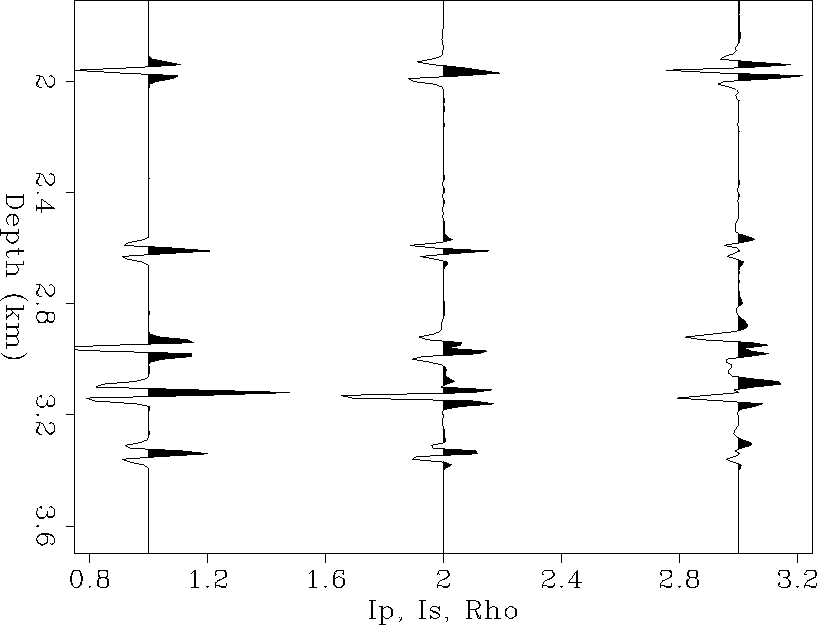This section describes the inversion of a single Rpp and ![]() offset gather by SVD to produce a single depth trace each of P-impedance
(Ip), S-impedance (Is), and density (
offset gather by SVD to produce a single depth trace each of P-impedance
(Ip), S-impedance (Is), and density (![]() ). Recall that these
parameters are of the form
). Recall that these
parameters are of the form ![]() , where
, where ![]() is the
change in a given property value, and
is the
change in a given property value, and ![]() is the
average property value, i.e. -- relative changes in elastic
material properties.
is the
average property value, i.e. -- relative changes in elastic
material properties.
Figure ![[*]](http://sepwww.stanford.edu/latex2html/cross_ref_motif.gif) shows the three elastic parameter traces Ip(z;x),
Is(z;x) and
shows the three elastic parameter traces Ip(z;x),
Is(z;x) and ![]() (as a function of depth z, for a fixed
surface position x).
The first depth trace is the P-impedance trace
Ip. The correct model values (in %) from Table
(as a function of depth z, for a fixed
surface position x).
The first depth trace is the P-impedance trace
Ip. The correct model values (in %) from Table ![[*]](http://sepwww.stanford.edu/latex2html/cross_ref_motif.gif) are plotted in
parentheses, adjacent to the m/i estimated peak values. The Ip
estimates are seen to be reasonably accurate. Again the first event
at 1960 m is weak due to the mute pattern in the shot records affecting
the Rpp estimation, and the events below the gas (2960 m) are weak
due to attenuation through the low Q gas layer. The Is
estimates are also seen to be quite reasonable, although perhaps
less robust than Ip. Also, although the Is relative
change of 0% has been correctly estimated at the gas sand, there
are wavelet sidelobe artifacts which would make it difficult to resolve
in field data situations. A similar situation applies to the impedance
change at 3100 m where two closely spaced reflections overlap into
one apparent reflection. This is analogous to a thin bed resolution
problem and linearized amplitude tuning effects. Although the
Is estimate is correct at 3100 m (somewhat fortuitously),
the overlap of two
distinct wavelets erroneously suggests a single impedance change of a large
negative polarity which is clearly incorrect. Lastly, the density variation
is completely unreliable, except for perhaps the 1960 m event which has
the correct polarity and roughly approximate amplitude due to its
large specular angle coverage (
are plotted in
parentheses, adjacent to the m/i estimated peak values. The Ip
estimates are seen to be reasonably accurate. Again the first event
at 1960 m is weak due to the mute pattern in the shot records affecting
the Rpp estimation, and the events below the gas (2960 m) are weak
due to attenuation through the low Q gas layer. The Is
estimates are also seen to be quite reasonable, although perhaps
less robust than Ip. Also, although the Is relative
change of 0% has been correctly estimated at the gas sand, there
are wavelet sidelobe artifacts which would make it difficult to resolve
in field data situations. A similar situation applies to the impedance
change at 3100 m where two closely spaced reflections overlap into
one apparent reflection. This is analogous to a thin bed resolution
problem and linearized amplitude tuning effects. Although the
Is estimate is correct at 3100 m (somewhat fortuitously),
the overlap of two
distinct wavelets erroneously suggests a single impedance change of a large
negative polarity which is clearly incorrect. Lastly, the density variation
is completely unreliable, except for perhaps the 1960 m event which has
the correct polarity and roughly approximate amplitude due to its
large specular angle coverage (![]() ). This will be explained
further in the next section under the topic of choice of elastic
parameterization for the inversion.
). This will be explained
further in the next section under the topic of choice of elastic
parameterization for the inversion.
 |
In summary, with accurate synthetic data and a realistic recording geometry and background model, we are able to recover very reasonable Ip estimates, somewhat less robust Is estimates, and very little (if any) information about density variations.